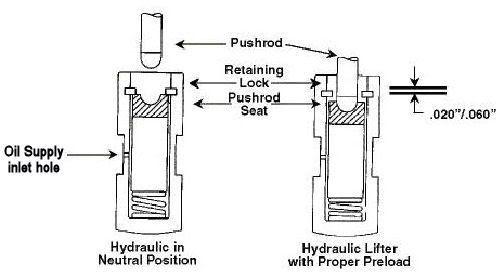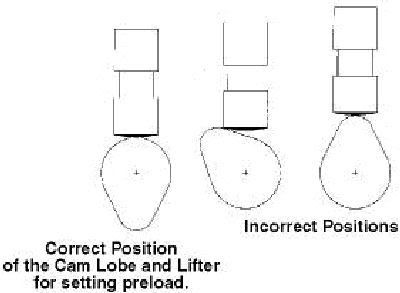There seems to be a high number of Jeepers with lifter and/or valve train noise so I thought a new post would be helpful.
First we need to mention most Jeep engines, with the exception of small and big block Chevrolets, have been made with non-adjustable valves and rocker arms.
The Basic Lifter OperationA lifter uses simple valving and the engine's oil pressure to adjust its length slightly, thereby maintaining zero clearance in the valve train. As the engine expands and contracts or or cam and rocker wear, the oil in the reservoir of the lifter fills and bleeds off, maintaning the correct amount of valve clearance.
Why Use Hydraulic liftersSince 1967 the automotive industry has used hydraulic lifters for several reasons. When compared to solid mechanical lifters, the hydraulics are:
1. Quieter
2. Lower maintenance.
3. An ability to adjust for thermal expansion of the engine.
4. Built in shock absorber, eases stress on valve train.
5. Can be designed to accommodate different engine RPM ranges.
What's the difference between Hydraulic & Solid Mechanical Lifters? Basically, the hydraulic lifter pushrod seat is moveable, the mechanical lifter seat is not. Both lifter types look the same from the outside, with both having pushrod seats held in by a retaining lock. The pushrod seat in a mechanical lifter usually registers upon an internal step inside the lifter body preventing it from moving (thus it gets the nickname "Solid Lifter").
What's below the pushrod seat in the hydraulic lifter is a different story. Its pushrod seat is not restricted by a step, but instead sits on top of a moveable hydraulic mechanism which acts like a tiny hydraulic pump. Below this mechanism is valving and a spring to produce an upward force, moving the pushrod seat upward against the retaining lock.
What is Hydraulic Lifter Preload All About? Mechanical cam designs require a running clearance or valve lash, while hydraulic lifters are just the opposite. When the rocker arm assembly is properly torqued down into position, the pushrod must take up all the clearance and descend into the hydraulic lifter, causing the pushrod seat to move down by .020" to .060". The distance that the pushrod seat moves down away from the retaining lock is the "Lifter Preload". The hydraulic mechanism requires this precise amount of "preload" for it to do its job properly. See figure below.
If clearance exists between the pushrod and the seat in the hydraulic lifter, after the rocker arm assembly has been torqued down, you will have no lifter preload. In this case the valve train will be noisy when the engine is running. All of the hydraulic force produced by the lifter will be exerted against the lifter's retaining lock, and this could cause the lock to fail. If the opposite occurs and the pushrod descends too far (more than .060"), then you have excessive lifter preload. In theory, a hydraulic lifter can pump up whatever preload you put into it.
Therefore with excessive preload, as the engine RPM and oil pressure increases, the hydraulic mechanism will pump-up the pushrod seat. This will cause the valve to be open longer and the lift to be higher. This will decrease the cylinder pressure, lowering the performance of the engine. If the preload is excessive it may cause "backfiring" from the engine. How to correct this situation will be explained in the next sections.
 When Rebuilding an engine, what causes Lifter Preload to Change?
When Rebuilding an engine, what causes Lifter Preload to Change? Almost anything can affect lifter preload. If you do a valve job, surface the block or heads, change the head gasket thickness, or buy a new camshaft, the amount of preload can be affected. Sometimes these changes cancel one another out and your preload stays the same; this is more by luck than design. This is why you must always inspect the amount of preload the lifter has when reassembling the engine and be sure that it is correct.
Fast and Easy Way to Check Hydraulic Lifter Preload when using Non-Adjustable Rocker Arms With the cam, hydraulic lifters and pushrods in place, install your rocker arm assembly. Use the prescribed method in your repair manual and torque down all the valve train bolts in the proper sequence. Pick a cylinder that you are going to check. Hand rotate the engine in its normal direction of rotation until both valves are closed. You are on the compression cycle for that cylinder. (At this position the valve springs are at their least amount of tension making the job a little easier to do.)
Wait a few minutes, allowing the lifters to bleed down. Now, lay a rigid straightedge across the cylinder head, supporting it on the surface of the head where the valve cover gasket would go. Using a metal scribe and the straightedge, carefully scribe a line on both pushrods. Now carefully remove the torque from all valve train bolts, removing any pressure from the pushrods. Wait a few minutes for the pushrod seat in the hydraulic lifter to move back to the neutral position. Carefully scribe a new line on both pushrods.
Measure the distance between the two scribe marks, it represents the amount of lifter preload. If the lines are .020" to .060" apart you have proper lifter preload. If the lines are the same or less than .020" apart you have no, or insufficient, preload. If the lines are further apart than .060", you have excessive lifter preload. To bring your preload into tolerance, use one of the methods described in the next section if necessary
Methods to Adjust for Proper Hydraulic Lifter Preload There are several different methods for increasing or decreasing the amount of lifter preload, depending on valve train design and how the rocker arm is held onto the cylinder head. Keep in mind that the automotive manufacturers have made changes to the valve train over the years. What may work on one year's engine may not work for another, even though they are basically the same engine. There is one method that universally works on all these engines, change the pushrod length!
Use a longer pushrod to increase preload, a shorter to reduce preload. Many vendors offer various length pushrods, and offer some custom length pushrods. Here are a few types of custom length pushrods: Bottleneck stud shims Bridge mount rocker arm shims Pedestal mount rocker arm shims Adjustable pushrods Conversion rocker arm studs "Kool Nut" adjusting nuts Guideplate and rocker arm conversion kits Adjustable rocker arms (both stud and shaft mounted) Replacement guideplates and studs
 When the Lifter Valve Fails the Lifter can Collapse
When the Lifter Valve Fails the Lifter can CollapseThe lifter will not hold pressure to keep it pumped up or the spring fails causing the same condition. Usually when a lifter starts to fail it bleeds down fast, all lifters have bleed down rates but normally will hold a pre-charge overnight or while sitting for a while. But when they bleed down too fast they need to pump up every time the engine is started and rocker clatter will be heard for 1-2 minutes. This is the early stage of lifter failure. Once the lifter valve totally fails it will no longer hold any pressure. The only course at that point is to replace the lifters with a new set and matched cam which are normally sold as a kit. With lifters prevention is everything, which is why I always use high quality oil and do frequent changes so no dirt, varnish, or sludge form inside the engine. When I get an old engine I do more frequent changes to clean out the dirt & sludge which has built up and sometimes I will pull the oil pan which will have 1/4-1/2 inch of sludge buildup on the bottom and will not flush out with frequent oil changes. After cleaning the pan oil changes look much cleaner at each change. I am currently running Mobile1 synthetic 15-50 weight since my 2.5L Jeep engine now has over a 100K you donít want oil that gets as thin as water when it heats up but a 10-30 is good for new engines with tight clearances. The other most important engine killer is heat, when oil gets too hot it creates a dark baked on varnish like film on internal engine parts which does not come off easily, if your engine has old dirty oil and it overheats you are cutting the engines life and an early rebuild may be in the near future.
The most Common Cause of Lifter NoiseRunning too long between oil changes is unfortunately the most common cause. I shoot for 3000 miles or 6 months, whichever comes first, between changes. But If I get to 4000 miles I make the oil change a high priority. Changing to synthetic (I only use Mobil 1) can have good results. Many times it takes a couple of oil changes to get the old crap out of your engine that's been building over the miles from petroleum based, especially the relatively cheap petroleum based oils with high sulfur content. (I hear Pennzoil has the worst sludging problem, but can't confirm. I never touch the stuff) Most synthetics do a very good job at cleaning your engine and keeping it clean...during the cleaning process, stuff gets dislodged and may float around your engine until the next oil change. There are several detergent products out there, but I find that dumping a quart of ATF or Sea Foam into the crankcase and driving 100-200 miles before changing oil will in many cases do the trick. It may take a couple of oil changes to get rid of it all. Just make sure you either drain some oil out or wait until you are down a quart so that you don't overfill the crankcase. Hold close to good maintenance techniques and you will get 300K from a good engine as many others have done. If you do a lot of off-road driving you also need to change the oil more. Most air filters donít stop dust particles under 30 microns and high flow air filters can allow even more dirt through so you sacrifice engine life for more power. All the finer dust sucked into your engine winds up in your oil along with carbon from combustion and heavy metals from normal wear.
http://www.bobistheoilguy.com/Remember, there's nothing wrong with these Jeeps that money can't fix.
Some information was taken from CraneCams
http://www.cranecams.com/